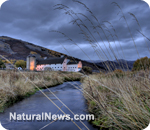 A number of current and former US intelligence officials, who spoke on the condition of anonymity, said Israel is the top threat for CIA’s Near East Division which undertakes Washington’s espionage activities across the Middle East, the Associated Press reported on Saturday.
A number of current and former US intelligence officials, who spoke on the condition of anonymity, said Israel is the top threat for CIA’s Near East Division which undertakes Washington’s espionage activities across the Middle East, the Associated Press reported on Saturday.
The report comes on the heels of a new revelation by the White House that the houses of several CIA agents in Israel have been recently broken into.





 But today, Jackson County, Oregon says it owns YOUR rainwater, and the county has sentenced a man to 30 days in jail and fined him over $1500, for the supposed "crime" of collecting rainwater on his own property.
But today, Jackson County, Oregon says it owns YOUR rainwater, and the county has sentenced a man to 30 days in jail and fined him over $1500, for the supposed "crime" of collecting rainwater on his own property. A lot of the world's misery can be traced to people who lack the wiring for empathy. What can we do to contain the damage they cause?
A lot of the world's misery can be traced to people who lack the wiring for empathy. What can we do to contain the damage they cause?

 Has there ever been a Middle Eastern war of such hypocrisy? A war of such cowardice and such mean morality, of such false rhetoric and such public humiliation? I'm not talking about the physical victims of the Syrian tragedy.
Has there ever been a Middle Eastern war of such hypocrisy? A war of such cowardice and such mean morality, of such false rhetoric and such public humiliation? I'm not talking about the physical victims of the Syrian tragedy. The United States is now well on its way to a renewables-crushing, decades-long shale-gas bridge with an economic commitment to exporting this non-renewable domestic fuel and, absent dramatic market changes, there’s not much Congressman Markey or anyone else can do to stop it.
The United States is now well on its way to a renewables-crushing, decades-long shale-gas bridge with an economic commitment to exporting this non-renewable domestic fuel and, absent dramatic market changes, there’s not much Congressman Markey or anyone else can do to stop it. McKesson Corp. will pay $151 million to 29 states and the District of Columbia to settle a lawsuit alleging the company inflated prices of hundreds of prescription drugs, causing state Medicaid programs to overpay millions of dollars in reimbursements, officials said Friday.
McKesson Corp. will pay $151 million to 29 states and the District of Columbia to settle a lawsuit alleging the company inflated prices of hundreds of prescription drugs, causing state Medicaid programs to overpay millions of dollars in reimbursements, officials said Friday. The CIA station chief opened the locked box containing the sensitive equipment he used from his home in Tel Aviv, Israel, to communicate with CIA headquarters in Virginia, only to find that someone had tampered with it. He sent word to his superiors about the break-in.
The CIA station chief opened the locked box containing the sensitive equipment he used from his home in Tel Aviv, Israel, to communicate with CIA headquarters in Virginia, only to find that someone had tampered with it. He sent word to his superiors about the break-in.






























